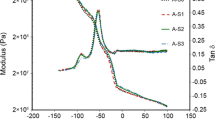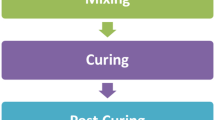Abstract
Typically, cracking can be observed on the rubber surface when it is stretched and exposed to the ozone. Ozone-induced stress cracking is considered a problem as it contributes to diminishing the appearance and serviceability of rubber products. Ozone concentration form cracks which cause potential failure in the rubber. This study investigates the influence of ozone exposure and discusses most of the effects resulting from the ozone attack. Water serves a barrier and protects rubber from the ozone attack. Many cracks formed on the rubber surface at a high strain compared to that of a low strain. The distribution of crack lengths represents a complex function of time and strain. The chemical reaction of ozone proceeds in the absence of strain which results in a shiny appearance and is tacky due to uniform occurrence of ozonolysis on the rubber surface.
Similar content being viewed by others
References
BRADEN, M. AND GENT, A.N. (1960) The Attack of Ozone on Stretched Rubber Vulcanisates. II Conditions for cut growth. J. Appl. Polym. Sci., 7, 100–106.
LAKE, G.J. AND THOMAS, A.G. (1967) Ozone Attack on Strained Rubber, Proc. Int. Rubb. Conf., 525–536.
ROTH, J.A. AND SULLIVAN, D.E. (1981) Solubility of Ozone in Water. J. Indus. Eng. Chem. Fund., 20, 137–140.
LAKE, G.J. AND MENTE, P.G. (1992) Ozone Cracking and Protection of Elastomers at High and Low Temperatures. J. Nat. Rubb. Res., 7, 1–13.
ZUEV, YU. S. AND MALOFEEVSKAYA, V.F. (1961) Effect of Moisture on the Resistance of Rubber to Ozone Cracking. Soviet Rubb. Technol., 6(20), 23–26.
BEATTY, J.R. (1964) Fatigue of Rubber. J. Rubb. Chem. Technol., 37, 1341–1364
LINDLEY, P.B. AND THOMAS, A.G. (1962) Fundamental Study of the Fatigue of Rubber, 4th Rubber Technology Conference, London: Institution of the Rubber Industry. 1–14.
MUHR, A.H. (2006) Fracture of Rubber — steel Laminated Bearing, Chapter 15 in Elastomers and Components: Service Life Prediction, (Ed.)V.A. Coveney. Cambridge: Woodhead Publishing in Materials.
JONES, K.P. (1968) The Distribution of Ozone at the Earth’s Surface, J. Inst. Rubb. Indus., 194–198.
Author information
Authors and Affiliations
Corresponding author
Rights and permissions
About this article
Cite this article
Kamaruddin, S., Muhr, A.H. Investigation of Ozone Cracking on Natural Rubber. J Rubber Res 21, 73–93 (2018). https://doi.org/10.1007/BF03449163
Received:
Accepted:
Published:
Issue Date:
DOI: https://doi.org/10.1007/BF03449163




